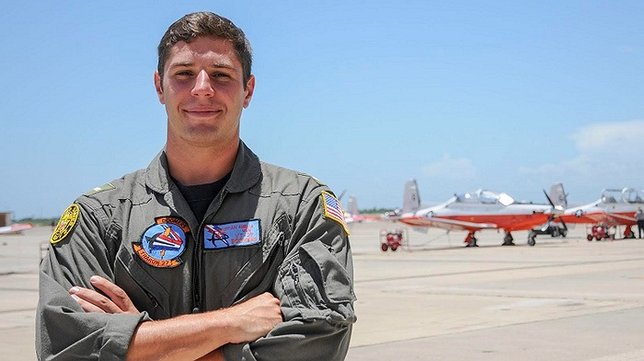Babylon, NY - August 11, 2016 - A 2011 Babylon High School graduate and Babylon, New York native participates in the lengthy and rigorous training process that transforms new U.S. Navy Officers into Naval Aviators.
Ensign Christian Amelia is a student naval avaiator with the “Rangers” Training Squadron (VT-27), based in Corpus, Christi, Texas, that operates the T-6B Texan II aircraft. As a student, Amelia is responsible for learning to fly aircraft both effectively and efficiently so he can become one of the finest aviators in the Navy, “I love that I am learning a unique skill, it’s an honor to learn from the best and fly for the Navy,” said Amelia.
The T-6B Texan is a training aircraft that is powered by a 1,100 shaft horsepower, free-turbine, turboprop single-engine, four-bladed propeller, with a cruising speed of 310 mph.
VT-27’s primary mission is to train future naval aviators to fly as well as instill leadership and officer values, Navy officials explained. Students must complete four phases of flight training in order to graduate, including aviation pre-flight indoctrination, primary flight training and advanced flight training. After successfully completing the rigorous program, naval aviators earn their coveted “Wings of Gold.”
After graduation, pilots continue their training to learn how to fly a specific aircraft, such as the Navy’s F/A-18 Hornet strike fighter jet, the P-8 Poseidon maritime patrol aircraft or the SH-60 Seahawk helicopter. They are later assigned to a ship or land-based squadron.
Many of these pilots will fly aircraft which take off from and land aboard aircraft carriers and other aviation and air-capable ships, a unique capability which allows Naval Air Forces to operate integrally with surface forces anywhere on the world’s oceans. Recently, Navy strike aircraft operating from aircraft carriers sailing in the Eastern Mediterranean Sea and from Middle East waters have launched hundreds of missions against terrorist targets in Iraq and Syria.
As a member of one of the U.S. Navy’s squadrons with the newest aircraft platforms, Amelia said he and other VT-27 sailors are proud to be part of a warfighting team that readily defends America at all times.
“This command has a great tight-knit family environment,” said Amelia. “Not only do they care about making us successful pilots but a successful person both professionally and personally” said Amelia.
Sailors’ jobs are highly varied at VT-27, according to Navy officials. Approximately 60 men and women officers and 15 civilian employees, make up and keep all parts of the squadron running smoothly -- this includes everything from training the new aviators, maintaining airframes and engines, processing paperwork, along with handling and flying the aircraft.
“What the men and women of this squadron accomplish every day is nothing short of miraculous," explained CDR Corbett Dixon, Commanding Officer of VT-27. “The students are in the process of moving from just another college graduate in society, to someone who sacrifices their own time and effort for society. That’s what it means to serve in the Navy. That’s what they’re learning as they learn to fly. And the staff here, the instructor pilots and civilians, put in an amazing amount of effort day in and day out, to ensure that we send the best young men and women forward to serve our nation, with all the skills, dedication and integrity necessary to serve successfully.”
Serving in the Navy, Amelia is learning about being a more responsible leader, Sailor and person through handling numerous responsibilities.
"The Navy has instilled in me the needed confidence to push myself to new limits that I never thought were possible to overcome,” said Amelia.
By Mass Communication Specialist 1st Class Sunday Sawyer, Navy Office of Community Outreach
On our planet, more than 70 percent of which is covered by water, being there means having the ability to act from the sea. The Navy is uniquely positioned to be there; the world's oceans give the Navy the power to protect America's interests anywhere, and at any time. Your Navy protects and defends America on the world's oceans. Navy ships, submarines, aircraft and, most importantly, tens of thousands of America's finest young men and women are deployed around the world doing just that. They are there now. They will be there when we are sleeping tonight. They will be there every Saturday, Sunday and holiday this year. They are there around the clock, far from our shores, defending America at all times.










